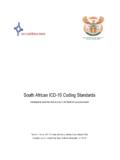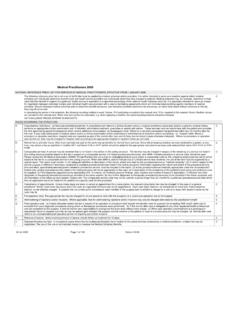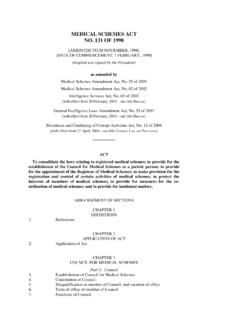Transcription of NATIONAL REFERENCE PRICE LIST FOR AMBULANCE …
1 AMBULANCE Services 2006. NATIONAL REFERENCE PRICE LIST FOR AMBULANCE SERVICES, EFFECTIVE FROM 1 JANUARY 2006. The following REFERENCE PRICE list is not a set of tariffs that must be applied by medical schemes and/or providers. It is rather intended to serve as a baseline against which medical schemes can individually determine benefit levels and health service providers can individually determine fees charged to patients. Medical schemes may, for example, determine in their rules that their benefit in respect of a particular health service is equivalent to a specified percentage of the NATIONAL health REFERENCE PRICE list. It is especially intended to serve as a basis for negotiation between individual funders and individual health care providers with a view to facilitating agreements which will minimise balance billing against members of medical schemes.
2 Should individual medical schemes wish to determine benefit structures, and individual providers determine fee structures, on some other basis without REFERENCE to this list, they may do so as well. In calculating the prices in this schedule, the following rounding method is used: Values R10 and below rounded to the nearest cent, R10+ rounded to the nearest 10cent. Modifier values are rounded to the nearest cent. When new item prices are calculated, when applying a modifier, the same rounding scheme should be followed. ALL PRICES ARE VAT EXCLUSIVE. Preamble It is recommended that, when such benefits are granted, the following should be clearly specified in the scheme's rules: The limitation, if any, for such benefits.
3 REGULATIONS DEFINING THE SCOPE OF THE PROFESSION OF EMERGENCY CARE. GENERAL RULES. 001 Long distance claims (items 111, 129 and 141) to be rejected unless distance travelled by patient is reflected. Long distance charges may not include item codes 100, 103, 125, 127, 131 or 133. Long distance claims (items 112, 130 and 142) to be rejected unless the distance is reflected. Long distance charges may not include item codes 100, 103, 125, 127, 131 or 133. 002 No after hours fees may be charged 003 Item code 151 may only be charged for services provided by a second vehicle (either AMBULANCE or response vehicle) and shall be accompanied by a motivation. 004 Guidelines for information required on each account : Name of service BHF practice number Address Telephone number Pre-authorisation number The name of the member The name of the patient The name of the medical scheme The membership number of the member Diagnosis of patient's condition Summary of medical procedures undertaken on patient and vital signs of patient Summary of all equipment used The date on which the service was rendered.
4 Name and HPCSA registration number of care providers Name, practice number and HPCSA registration number of medical doctor Response vehicle: Details of vehicle driver and intervention undertaken on patient The code number of the procedure used in the NATIONAL REFERENCE PRICE List. 005 It is recommended that, when such benefits are granted, drugs, consumables and disposable items used during a procedure or issued to a patient on discharge will only be reimbursed by a medical scheme if the appropriate code is supplied on the account. 006 A BLS service (Practice type "51200") may not charge for ILS or ALS, an ILS service (Practice type "51100") may not charge for ALS. An ALS service (Practice type "51000") may charge all codes.
5 04 Feb 2006 Page 1 of 6 Version AMBULANCE Services 2006. Definitions of AMBULANCE Patient Transfer Basic Life Support - A callout where patient assessment, treatment administration, interventions undertaken and subsequent monitoring fall within the scope of practice of a registered Basic AMBULANCE Assistant whilst patient in transit. Intermediate Life Support - A callout where the patient assessment, treatment administration, interventions undertaken and subsequent monitoring fall within the scope of practice of a registered AMBULANCE Emergency Assistant (AEA). ( Initiating and/or maintaining IV therapy, nebulisation etc.) whilst patient in transit. Advanced Life Support - A callout where patient assessment, treatment administration, interventions undertaken and subsequent monitoring fall within the scope of practice of a registered Paramedic (CCA and NDIP) whilst patient in transport.
6 This includes all incubated neonatal transfers. NOTES: Incubator transfers require ALS trained personnel in accordance with the HPCSA ruling. If a hospital or the attending physician requires a Paramedic to accompany the patient on a transfer in the event of the patient needing ALS intervention the doctor requesting the Paramedic must write a detailed motivational letter in order for ALS to be charged. If a hospital or the attending physician requires a Paramedic to accompany the patient on a transfer in the event of the patient needing ILS intervention the doctor requesting the Paramedic must write a detailed motivational letter in order for ILS to be charged. In order to bill as an advanced life support call, a registered advanced life support provider must have examined, treated and monitored the patient while in transit to hospital.
7 In order to bill as an intermediate life support call, a registered intermediate life support provider must have examined, treated and monitored the patient while in transit to hospital. Where an ALS provider is in attendance at a callout but does not do any interventions at an ALS level on the patient or ALS monitoring and presence is not required, the billing will be based on a lower level dependent on the care given to the patient. ( Paramedic sites IV line or nebulises patient with a B agonist - this falls within the practice of an AEA and thus is to be billed as an ILS call not an ALS call). Where an ILS provider is in attendance at a callout but does not do any interventions at an ILS level on the patient or ILS monitoring and presence is not required, the billing will be BLS.
8 Where the management undertaken by a paramedic or AEA fall within the scope of practice of a BAA the call must be at a BLS level. Please Note : The amounts reflected in the NRPL for each level of care is inclusive of any disposables (except for pacing pads, heimlich valves, high capacity giving sets, dial a flow, intra-osseous needles) and drugs used in the management of the patient, as per attached nationally approved medication protocols. Haemaccel and colloid solution may be charged separately. Claims for patient discharges home will only be entertained if accompanied by a written motivation from the attending physician who requested such transport - clearly stating why an AMBULANCE is required for such a transport and what medical assistance the patient requires on route.
9 04 Feb 2006 Page 2 of 6 Version AMBULANCE Services 2006. DEFINITION: RESPONSE VEHICLES. Response vehicles only - Advance Life Support (ALS) A clear definition must be drawn between the acute primary response and a booked call. 1. The Acute Primary Response is defined as follows: A call that is received for medical assistance to a member of the public who is ill or injured at work, home or in a public area motor vehicle accident. Should a response vehicle be dispatched to the scene of the emergency and the patient is in need of Advanced Life Support and which is rendered by ALS Personnel CCA or NATIONAL Diploma, the respective service shall be entitled to bill on item 131, for such service.
10 However, the service which is transporting the patient shall not be able to levy a bill, as the cost of transportation is included in the ALS rate under items 131 and 133. Furthermore the ALS response vehicle personnel must accompany the patient to hospital to entitle the service to bill for said ALS services rendered. 2. In the event of a service rendering ALS and not having its own AMBULANCE in which to transport the patient to a medical facility, and makes use of another service, only the bill for the response vehicle may be levied as the ALS bill under items 131 and 133. Since the ALS tariff already includes transportation, the response vehicle service is responsible for the bill for the other service provider, which will be levied at a BLS rate.












